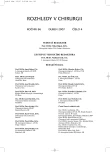Experience with Peroperative Choledochoscopy
Authors:
J. Schwarz; J. Šimša; F. Pazdírek
Authors‘ workplace:
Chirurgická klinika UK 2. LF a FN Praha-Motol, přednosta: prof. MUDr. J. Hoch, CSc.
Published in:
Rozhl. Chir., 2007, roč. 86, č. 4, s. 180-183.
Category:
Monothematic special - Original
Overview
Introduction:
Choledocholithiasis is nowadays managed endoscopicaly in the majority of patients. Open surgery with CBD exploration remains important, when endoscopy failed. The completeness of stones‘ extraction may be confirmed with choledochoscopy.
Method:
The retrospective analysis of patients operated on choledocholithiasis within the period of seven years was performed. Two groups of patients were studied. First group was managed by choledocholithotomy followed by choledochoscopy. Second group underwent exploration of the common bile duct without choledochoscopy. Frequency of the residual stones in both groups was studied. Statistical evaluation was done using α² test. The value of p < 0.05 was settled as statistically significant.
Results:
In the study period of seven years 46 patients were operated on CBD stones. Choledocholithotomy followed by intra-operative choledochoscopy was performed in 21 patients. No remnant stones were recorded in this group. Exploration of the CBD with stone extraction without choledochoscopy was done in 25 patients. In this group residual stones occurred in 3 patients. The result was not statistically significant, p = 0.10.
Conclusions:
According to our experience and literature, intra-operative choledochoscopy can reduce frequency of the residual CBD stones. Peroperative choledochoscopy can thus be recommended as an accessory procedure to CBD exploration to prevent stones oversight.
Key words:
choledocholithiasis – peroperative choledochoscopy – remanent lithiasis
Sources
1. Frič, P., Ryska, M. Digestivní endoskopie a laparoskopická chirurgie. Praha Publishing spol. s.r.o., 1996: s. 121–127.
2. Eubanks, W. S., Swanstrom, L. L., Soper, N. J. Mastery of Endoscopic and Laparoscopic Surgery. Lippincott Williams and Wilkins, Philadelphia 2000: s. 233–240.
3. Ponsky, J. L. Complications of Endoscopic and Laparoscopic Surgery. Lippincott – Raven Publishers, Philadelphia, 1997: s. 57–73.
4. Shore, J. M., Shore, E. Operative biliary endoscopy: Experience with the flexible choledochoscope in 100 consecutive choledocholithotomies. Ann. Surg., 1970, 171: s. 269.
5. Niederle, B. Chirurgie žlučových cest. Avicenum Praha, 1977: s. 195–199.
6. Decker, G., Borie, F., Millat, B., et al. One hundred laparoscopic choledochotomies with primary closure of the common bile duct. Surg. Endosc., 2003; 17: s. 12–18.
7. Czudek S., Kubiczek J., Branný J. Laparoskopická cholecystektomie a choledocholitiáza. Rozhl. Chir., 1993; 72: s. 103–105.
8. Dion, Y. M., Ratelle, R., Morin, J., et al. Common bile duct exploration: the place of laparoscopic choledochotomy. Surg. Laparosc. Endosc., 1994; 4: s. 419–424.
9. Menzies, D., Motson, R. W. Operative common bile duct imaging by operative cholangiography and flexible choledochoscopy. Br. J. Surg., 1992; 79: s. 815–817.
10. Ciesielczyk, B., Nowak, M. Intraoperative monitoring of the biliary tracts as a means preventing choledocholithiasis oversight. Folia Morphol. (Warsz). 2004; 63: s. 347–349.
Labels
Surgery Orthopaedics Trauma surgeryArticle was published in
Perspectives in Surgery

2007 Issue 4
Most read in this issue
- Treatment of Gunshot Wounds and Prevention of Complications during the Healing Process
- Surgical Treatment of Bleeding Gastroduodenal Ulcer
- Acute Intestinal Ischaemia
- Long-term Results after Radical Resections for Pancreatic Ductal Adenocarcinoma – 10 Years Experience
